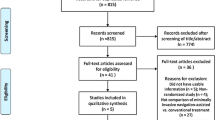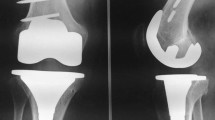Abstract
Purpose
Accurate implant position in total knee arthroplasty (TKA) can potentially lead to better long-term functional outcomes and implant survival. Recent studies on whether better clinical results could be obtained from computer-navigated or conventional TKA were inconclusive. In addition, recent reviews only included short-term follow-up studies without performing quantitative mid- to long-term follow-up analysis. Thus, the purpose of the present study was to perform a meta-analysis comparing mid- to long-term clinical outcomes (such as knee scoring and functional results) and radiological outcomes (such as normal alignment of the limb axis or component) between computer-navigated TKA and conventional TKA to determine which method of TKA could obtain better clinical and radiological results.
Methods
MEDLINE, EMBASE, the Cochrane Central Register of Controlled Trials (CENTRAL), Web of Science, and SCOPUS electronic databases were searched for relevant articles published through August 2018 that compared outcomes of computer-navigated TKA and conventional TKA. Data search, extraction, analysis, and quality assessment were performed according to the Cochrane Collaboration guidelines. Clinical and radiological outcomes of both techniques were evaluated using various outcome measures.
Results
Seven randomized controlled trials were included. Based on Knee Society Scores, the Western Ontario and McMaster Universities Osteoarthritis Index, pain, and range of motion, there were no significant differences in clinical outcomes between the two techniques. Based on outliers from the normal axis, outliers of femoral components in the coronal plane, and outliers of tibial components in the coronal plane, radiologic outcomes showed no significant differences between the two techniques either.
Conclusions
The present study revealed that there were no significant differences in clinical or radiological outcomes between computer-navigated TKA and conventional TKA. It remains unclear which TKA technique yields better results in terms of mid- to long-term clinical and radiological outcomes.
Level of evidence
I.



Similar content being viewed by others
References
Bae DK, Song SJ, Park CH, Ko YW, Lee H (2017) A comparison of the medium-term results of total knee arthroplasty using computer-assisted and conventional techniques to treat patients with extraarticular femoral deformities. J Arthroplast 32:71–78
Bae DK, Song SJ, Yoon KH, Noh JH, Moon SC (2012) Comparative study of tibial posterior slope angle following cruciate-retaining total knee arthroplasty using one of three implants. Int Orthop 36:755–760
Bargren JH, Blaha JD, Freeman MA (1983) Alignment in total knee arthroplasty. Correlated biomechanical and clinical observations. Clin Orthop Relat Res 173:178–183
Bauwens K, Matthes G, Wich M, Gebhard F, Hanson B, Ekkernkamp A et al (2007) Navigated total knee replacement. A meta-analysis. J Bone Jt Surg Am 89:261–269
Berend ME, Ritter MA, Meding JB, Faris PM, Keating EM, Redelman R et al (2004) Tibial component failure mechanisms in total knee arthroplasty. Clin Orthop Relat Res 428:26–34
Berger RA, Rubash HE, Seel MJ, Thompson WH, Crossett LS (1993) Determining the rotational alignment of the femoral component in total knee arthroplasty using the epicondylar axis. Clin Orthop Relat Res 286:40–47
Blakeney WG, Khan RJ, Palmer JL (2014) Functional outcomes following total knee arthroplasty: a randomised trial comparing computer-assisted surgery with conventional techniques. Knee 21:364–368
Bourne RB, Chesworth BM, Davis AM, Mahomed NN, Charron KD (2010) Patient satisfaction after total knee arthroplasty: who is satisfied and who is not? Clin Orthop Relat Res 468:57–63
Buechel FF Sr (2002) Long-term followup after mobile-bearing total knee replacement. Clin Orthop Relat Res 404:40–50
Chatain F, Gaillard TH, Denjean S, Tayot O (2013) Outcomes of 447 SCORE(R) highly congruent mobile-bearing total knee arthroplasties after 5–10 years follow-up. Orthop Traumatol Surg Res 99:681–686
Choong PF, Dowsey MM, Stoney JD (2009) Does accurate anatomical alignment result in better function and quality of life? Comparing conventional and computer-assisted total knee arthroplasty. J Arthroplast 24:560–569
Cip J, Obwegeser F, Benesch T, Bach C, Ruckenstuhl P, Martin A (2018) Twelve-year follow-up of navigated computer-assisted versus conventional total knee arthroplasty a prospective randomized comparative trial. J Arthroplast 33:1404–1411
Cip J, Widemschek M, Luegmair M, Sheinkop MB, Benesch T, Martin A (2014) Conventional versus computer-assisted technique for total knee arthroplasty: a minimum of 5-year follow-up of 200 patients in a prospective randomized comparative trial. J Arthroplast 29:1795–1802
de Steiger RN, Liu YL, Graves SE (2015) Computer navigation for total knee arthroplasty reduces revision rate for patients less than sixty-five years of age. J Bone Jt Surg Am 97:635–642
Delp SL, Stulberg SD, Davies B, Picard F, Leitner F (1998) Computer assisted knee replacement. Clin Orthop Relat Res 354:49–56
Ethgen O, Bruyere O, Richy F, Dardennes C, Reginster JY (2004) Health-related quality of life in total hip and total knee arthroplasty A qualitative and systematic review of the literature. J Bone Jt Surg Am 86:963–974
Harvie P, Sloan K, Beaver RJ (2012) Computer navigation vs conventional total knee arthroplasty five-year functional results of a prospective randomized trial. J Arthroplast 27:667–672
Hernandez-Vaquero D, Suarez-Vazquez A, Sandoval-Garcia MA, Noriega-Fernandez A (2010) Computer assistance increases precision of component placement in total knee arthroplasty with articular deformity. Clin Orthop Relat Res 468:1237–1241
Hetaimish BM, Khan MM, Simunovic N, Al-Harbi HH, Bhandari M, Zalzal PK (2012) Meta-analysis of navigation vs conventional total knee arthroplasty. J Arthroplast 27:1177–1182
Higgins JP, Altman DG, Gotzsche PC, Juni P, Moher D, Oxman AD et al (2011) The Cochrane collaboration’s tool for assessing risk of bias in randomised trials. BMJ 343:d5928
Ishida K, Matsumoto T, Tsumura N, Kubo S, Kitagawa A, Chin T et al (2011) Mid-term outcomes of computer-assisted total knee arthroplasty. Knee Surg Sports Traumatol Arthrosc 19:1107–1112
Jeffery RS, Morris RW, Denham RA (1991) Coronal alignment after total knee replacement. J Bone Jt Surg Br 73:709–714
Jenny JY, Boeri C (2001) Computer-assisted implantation of total knee prostheses: a case-control comparative study with classical instrumentation. Comput Aided Surg 6:217–220
Keating EM, Meding JB, Faris PM, Ritter MA (2002) Long-term followup of nonmodular total knee replacements. Clin Orthop Relat Res 404:34–39
Kim YH, Park JW, Kim JS (2018) 2017 Chitranjan S. Ranawat award: does computer navigation in knee arthroplasty improve functional outcomes in young patients? a randomized study. Clin Orthop Relat Res 476:6–15
Kim YH, Park JW, Kim JS (2017) The clinical outcome of computer-navigated compared with conventional knee arthroplasty in the same patients. J Bone Jt Surg Am 99:989–996
Kim YH, Park JW, Kim JS (2012) Computer-navigated versus conventional total knee arthroplasty: A prospective randomized trial. J Bone Jt Surg Am 94:2017–2024
Krackow KA, Pepe CL, Galloway EJ (1990) A mathematical analysis of the effect of flexion and rotation on apparent varus/valgus alignment at the knee. Orthopedics 13:861–868
Lin SY, Chen CH, Fu YC, Huang PJ, Lu CC, Su JY et al (2013) Comparison of the clinical and radiological outcomes of three minimally invasive techniques for total knee replacement at two years. Bone Jt J 95B:906–910
Longstaff LM, Sloan K, Stamp N, Scaddan M, Beaver R (2009) Good alignment after total knee arthroplasty leads to faster rehabilitation and better function. J Arthroplast 24:570–578
Lotke PA, Ecker ML (1977) Influence of positioning of prosthesis in total knee replacement. J Bone Jt Surg Am 59:77–79
Lützner J, Dexel J, Kirschner S (2013) No difference between computer-assisted and conventional total knee arthroplasty: Five-year results of a prospective randomised study. Knee Surg Sports Traumatol Arthrosc 21:2241–2247
Ma HM, Lu YC, Ho FY, Huang CH (2005) Long-term results of total condylar knee arthroplasty. J Arthroplast 20:580–584
Marques CJ, Daniel S, Sufi-Siavach A, Lampe F (2015) No differences in clinical outcomes between fixed- and mobile-bearing computer-assisted total knee arthroplasties and no correlations between navigation data and clinical scores. Knee Surg Sports Traumatol Arthrosc 23:1660–1668
Mason JB, Fehring TK, Estok R, Banel D, Fahrbach K (2007) Meta-analysis of alignment outcomes in computer-assisted total knee arthroplasty surgery. J Arthroplast 22:1097–1106
Mielke RK, Clemens U, Jens JH, Kershally S (2001) Navigation in knee endoprosthesis implantation–preliminary experiences and prospective comparative study with conventional implantation technique. Z Orthop Ihre Grenzgeb 139:109–116
Noble PC, Gordon MJ, Weiss JM, Reddix RN, Conditt MA, Mathis KB (2005) Does total knee replacement restore normal knee function? Clin Orthop Relat Res 431:157–165
Ollivier M, Parratte S, Lino L, Flecher X, Pesenti S, Argenson JN (2018) No benefit of computer-assisted TKA: 10-year results of a prospective randomized study. Clin Orthop Relat Res 476:126–134
Rebal BA, Babatunde OM, Lee JH, Geller JA, Patrick DA Jr, Macaulay W (2014) Imageless computer navigation in total knee arthroplasty provides superior short term functional outcomes: a meta-analysis. J Arthroplast 29:938–944
Ritter MA, Faris PM, Keating EM, Meding JB (1994) Postoperative alignment of total knee replacement. Its effect on survival. Clin Orthop Relat Res 299:153–156
Roberts TD, Clatworthy MG, Frampton CM, Young SW (2015) Does computer assisted navigation improve functional outcomes and implant survivability after total knee arthroplasty? J Arthroplast 30:59–63
Shin YS, Kim HJ, Ko YR, Yoon JR (2016) Minimally invasive navigation-assisted versus conventional total knee arthroplasty: a meta-analysis. Knee Surg Sports Traumatol Arthrosc 24:3425–3432
Song EK, Agrawal PR, Kim SK, Seo HY, Seon JK (2016) A randomized controlled clinical and radiological trial about outcomes of navigation-assisted TKA compared to conventional TKA: long-term follow-up. Knee Surg Sports Traumatol Arthrosc 24:3381–3386
Spencer JM, Chauhan SK, Sloan K, Taylor A, Beaver RJ (2007) Computer navigation versus conventional total knee replacement: no difference in functional results at two years. J Bone Jt Surg Br 89:477–480
Weng YJ, Hsu RW, Hsu WH (2009) Comparison of computer-assisted navigation and conventional instrumentation for bilateral total knee arthroplasty. J Arthroplast 24:668–673
Xie C, Liu K, Xiao L, Tang R (2012) Clinical outcomes after computer-assisted versus conventional total knee arthroplasty. Orthopedics 35:e647–e653
Funding
No funds were received in support of this work.
Author information
Authors and Affiliations
Corresponding author
Ethics declarations
Conflict of interest
The authors declare no conflict of interests regarding the publication of this paper.
Ethical approval
Because this study was a literature review, ethical approval was not obtained.
Additional information
Publisher's Note
Springer Nature remains neutral with regard to jurisdictional claims in published maps and institutional affiliations.
Electronic supplementary material
Below is the link to the electronic supplementary material.
Rights and permissions
About this article
Cite this article
Lee, DY., Park, YJ., Hwang, SC. et al. No differences in mid- to long-term outcomes of computer-assisted navigation versus conventional total knee arthroplasty. Knee Surg Sports Traumatol Arthrosc 28, 3183–3192 (2020). https://doi.org/10.1007/s00167-019-05808-5
Received:
Accepted:
Published:
Issue Date:
DOI: https://doi.org/10.1007/s00167-019-05808-5




